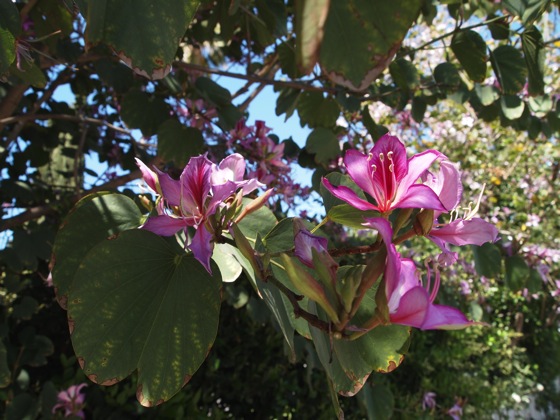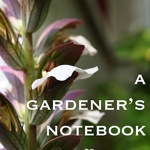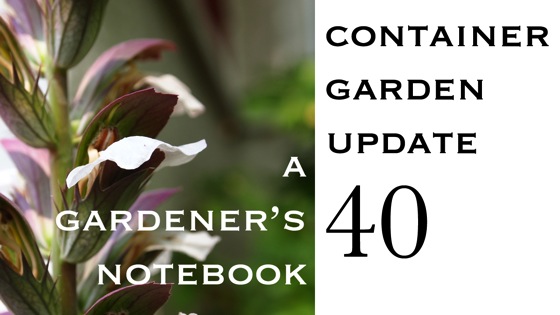Bauhinia
I am propagating several of these small trees from seed gathered in my garden. They have a nice compact habit and produce beautiful flowers. I was captivated with it the moment I saw it, even if it took some time — and help from the Goole+ #gardenchat folks to identify it. You can find a link to my recent “In the garden…” video on these trees below.

Bauhinia /boʊˈhɪniə/[4] is a genus of more than 200 species of flowering plants in the subfamily Caesalpinioideae of the large flowering plant family Fabaceae, with a pantropical distribution. The genus was named after the Bauhin brothers, Swiss–French botanists.
Many species are widely planted in the tropics as orchid trees, particularly in northern India, Vietnam and southeastern China. Other common names includeMountain Ebony and Kachnar (India and Pakistan). In the United States of America, the trees grow in Hawaii, coastal California, Texas, Louisiana, and Florida.Bauhinia ×blakeana is the floral emblem of Hong Kong—a stylized orchid tree flower appears on the Hong Kong flag and Hong Kong Airlines uses ‘Bauhinia’ as its radio callsign in air traffic communication.
Bauhinia trees typically reach a height of 6–12 m and their branches spread 3–6 m outwards. The lobed leaves usually are 10–15 cm across.
The five-petaled flowers are 7.5–12.5 cm diameter, generally in shades of red, pink, purple, orange, or yellow, and are often fragrant. The tree begins flowering in late winter and often continues to flower into early summer. Depending on the species, Bauhinia flowers are usually in magenta, mauve, pink or white hues with crimson highlights. — Wikipedia.org
- Bauhinia on Wikipedia
- Video: In the garden…September 24, 2014: Bauhinia previously on A Gardener’s Notebook
- Bauhinia at San Marcos Growers
- Bauhinia at USDA
Previously in the Interesting Plant series:
- Blue Flax (Linum lewisii)
- Chestnut (Castenea)
- Camellia japonica ‘Anemoniflora’
- Zaluzianskya villosa “Southern Lilac Drumsticks”
- Prickly Pear Cactus (Opuntia)
- Campanula
- Rudbeckia
- Caladium bicolor ‘White Queen’
- Fuchsia
- Palo Verde Tree (Parkinsonia florida)
- Espalier Fruit Trees
- California Poppy (Eschscholzia californica)
- Hydrangea ‘Zorro’
- Harlequin flower (Sparaxis tricolor)
- Erythronium
- Sempervivum
- Primula auricula
- Feathery Cassia (Senna auricula)
- Red Stick Dogwood (Cornus alba ‘Sibirica’)
- Japanese Maple (Acer palmatum)
- Kousa Dogwood (Cornus kousa)
- Giant Chalk Dudleya (Dudleya brittonii)
- Sunrose (Helianthemum nummularium)
- Australian/New Zealand Tea Tree (Leptospermum scoparium)
- Brugmansia Sanguinea
- Calico Monkeyflower (Mimulus pictus)
- Colocasia Esculenta
- Acer palmatum ‘Sango-kaku’ (Coral Bark Japanese Maple)
- Linderniaceae (formerly Torenia) Kuaui Deep Blue
- Passiflora (Passion flower)
- Firewheel Tree (Stenocarpus sinuatus)
- Anemone
- Allium Cowanii
- Symphyotrichum oblongifolius (Purple Aster)
- Hemerocallis ‘Derrick Cane’ (Daylily)
- Agastache ‘Aztec Rose’
- Rudbeckia hirta Moreno
- Kalanchoe Tomentosa
- Albuca namaquensis
- Hosta ‘Remember Me’
- Dahlia ‘Clair de Lune’
- Lovely silver-tinged fern on campus of Oberlin College, Ohio
- Tricolor Beech (Fagus sylvatica Purpurea Tricolor)
- Climbing Hydrangea (Hydrangea anomala petiolaris)
- Eremurus ‘Lemon Meringue’
- Lupine “Sunrise” (Lupinus hartwegii)
- Chinese Fringe Flower (Loropetalum chinense)
- Streptocarpus ‘Harlequin Blue’
- Nigella damascena (love-in-a-mist, ragged lady)
- Epiphyllum (Orchid Cactus)
- Sempervivum ‘Westerlin’
- Gladiolus ‘Kings Lynn’
- Hosta sieboldiana ‘Dorothy Benedict’
- Begonia “Escargot”
- Asparagus Pea (Psophocarpus tetragonolobus)
- Rosa banksiae (Lady Banks’ Rose)
- Primula ‘Victoriana Silver Laced Black’
- Oxalis versicolor
- Poached Egg Plant (Limnanthes douglasii)
- Parisian Carrots
- Fritillaria imperialis Rubra Maxima
- Clematis “Fascination”
- Swiss Chard “Bright Lights”
- Georgia Rattlesnake Melon
- Dianthus Barbathus “Green Ball” or “Green Trick”
- Coleus “Religious Radish”
- Black Forest Calla Lily
- Black Bamboo
Interesting Plant is a series from A Gardener’s Notebook blog and podcast that highlights the most interesting plants I find in my Internet and real-world travels — Douglas






